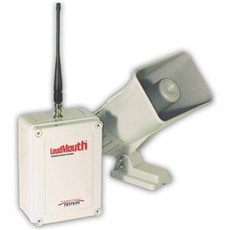 Public address or PA systems have been around for well over a hundred years. While the concept itself is not new, the technologies used in modern PA systems have changed and advanced considerably since the early days.
Public address or PA systems have been around for well over a hundred years. While the concept itself is not new, the technologies used in modern PA systems have changed and advanced considerably since the early days.
The basic concept of a PA system is simple: a microphone connects to an amplifier which in turn connects to a loudspeaker mounted in a central location for public delivery of announcements, alerts or other one-way communication.
Traditionally, PA systems are hardwired; the microphone, amplifier and speaker are physically connected with cables or wires. Today, however, PA systems can now be partially or completely wireless, thanks to the technology of radio.
One company that takes wireless PA to the max is Ritron. The company, based in Carmel, Indiana, sports a complete line of fixed mount wireless intercom, callbox and PA systems using two way radio technology. Ritron products are also made in the USA.
Ritron is a leading manufacturer of wireless PA systems. The Ritron Loudmouth Wireless Stand-Alone PA System allows a user to broadcast a message over the loudspeaker wirelessly - not from a traditional microphone, but direct from a two way radio. The wireless system provides safe and secure communications from mobile and handheld radios. Since it is wireless, the PA system can be set up quickly and easily without the expense of a wired installation. It installs almost anywhere and is a perfect solution for public address delivery in locations where the installation of a wired PA system is not practical or even feasible.
The Ritron Loudmouth Wireless Stand-Alone PA System is also easy to integrate with your existing arsenal of two way radios. It comes in two versions: UHF and VHF. The LM-U450 is field programmable to one of 77 UHF frequencies and the LM-V150 is field programmable to one of 26 VHF frequencies, including MURS, and can also receive NOAA weather channels and weather alerts. Using the software, the units are custom programmable to any frequency in their typical respective UHF or VHF range.
Both models feature a choice from 153 digital and analog Privacy Codes and one of 9 Paging Codes for added PA security access. Both models also include a loud, powerful PA horn type speaker capable of --95dB SPL@ 50 ft. Both versions operate on 110VAC and include a rechargeable back-up battery.
The Ritron Loudmouth Wireless Stand-Alone PA System is small and light, but it is sealed in a weather-resistant, industrial grade housing. With this rugged construction, the Loudmouth PA system is ideal for use in a variety of applications and outdoor locations such as schools, parking lots, factories, warehouses, marinas, golf courses, ball fields or nearly anywhere else a public address system is needed.
Sure, the public address system has been around for over a century, but it isn't getting older, it's getting better. With the integration of wireless radio technology, the classic PA system is enjoying new life.






